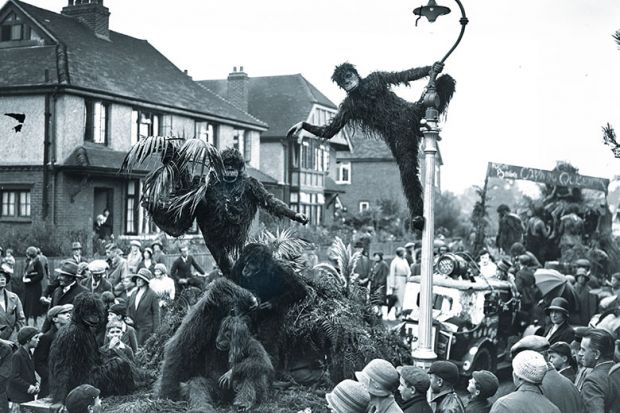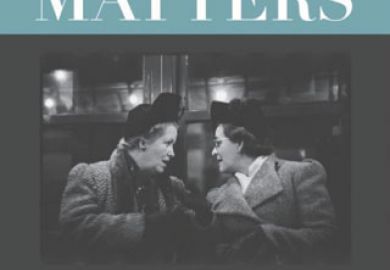Men tamed themselves. They invented morality. Thanks to lethal weaponry, they established equality – among men. Women had little impact on the evolution of modern Homo sapiens, except as sexual pawns in male negotiations. In Richard Wrangham’s universe, patriarchy prevails.
This fable resembles Sigmund Freud’s Totem and Taboo, in which a band of brothers overthrow, kill and eat their tyrannical father. Consumed with guilt, they institute moral laws. In Wrangham’s version, there’s no remorse. Instead, the killers revel in their new-found “coalitionary proactive aggression”, ready to dispatch anyone who steps out of line.
This, Wrangham would have us believe, is the foundation of morality. This “makes our species and societies truly unusual”. Not language or symbolism, not music or laughter, not art or religion: execution made us human.
A world expert on chimpanzees, Wrangham has long argued that chimpanzee strategies of lethal aggression foreshadow premeditated human group violence, including warfare. In this book, he proposes that modern humans emerged as “self-domesticated”. Two types of aggression were latent in our great ape ancestor, one reactive and defensive, the other premeditated. The selection pressures that domesticated modern humans reduced reactive violence, while enhancing their ability to plan group violence.
Wrangham is on solid ground comparing chimpanzees with their close cousins, the bonobos, presented as the self-domesticated ape. Dmitri Belyaev discovered the domestication syndrome experimenting with Siberian silver foxes. Breeding from individuals showing least fear and aggression to humans, he produced several features as by-products. Within six generations, young foxes were wagging tails, whimpering for attention and licking handlers. They also developed changes to skull shape so that males became more like females; shorter faces; and smaller teeth and jaws, bodies and brain weights. Wrangham details the hormonal and developmental mechanisms producing this pattern of traits through selection for one trait: juvenilisation.
Domestication and juvenilisation explain the difference between bonobos and chimps since their evolutionary divergence in the past million years. Compared with male-dominated, infanticidal chimpanzees, bonobos display playfulness and social tolerance, reduced body and brain size, and juvenilised skulls with small canines. Thanks to plentiful bouts of hoka-hoka (Congolese for genito-genital rubbing), females bond strongly, and dash to support each other if any male attempts violence and beat him up.
Here Wrangham argues convincingly that we are to our Middle Pleistocene ancestor what bonobos are to chimps and dogs to wolves. Domesticated through lower reactive aggression, our anatomy, physiology and emotional behaviour became progressively juvenile. (Even our vaunted brains got smaller from 20,000 years ago.)
We are extraordinarily prosocial, able to cooperate with complete strangers. Even bonobos, Wrangham emphasises, have orders of magnitude higher rates of aggression than we do. But why was this adaptive and how did it happen?
With bonobos, Wrangham immediately suggests that female strategies were implicated. Given the rich resources south of the Congo river, ancestral bonobo females could hang out together, unlike chimp females who must disperse to find food. Female alliances had the muscle to resist male aggression, leading to social and sexual selection for better-behaved males.
So wouldn’t females be central to an equivalent process among our Homo ancestors? Major evolutionary anthropologist Sarah Hrdy suggests how: babysitting. Congregating in tuber-rich environments, mothers could hand over their costly larger-brained babies to trusted female relatives as extra carers. This led to mutual mindreading and readiness to mesh mental states – the necessary platform for subsequent language evolution. Babies came under strong selection for prosociality to attract care from multiple adults. Surely this was the cradle for prolonged juvenile behaviours in Homo?
Surprisingly, Wrangham never engages with Hrdy’s ideas. Nor does he consider the evolution of women’s sexuality. Through concealed ovulation and sexual receptivity throughout their cycles, our foremothers increased the chances that males who stayed to help would father their children. Dominant males who attempted the old strategy of moving from one fertile female to the next were forced to spend more time guarding each mate. Homo erectus evolution was likely beset with sexual conflict between dominant males tied down to mate-guarding and those willing to provide by hunting. Outbreaks of sexual violence would have undermined childcare, constraining brain sizes for a long time.
Wrangham is surely right that dominant alpha males were the obstacle to the emergence of large-brained modern humans. But he is surely wrong to ignore female strategies of resistance. Bullying mattered most to mothers who needed energy for exceptionally demanding offspring. In the past 300,000 years, our foremothers selected less reactive, more child-friendly men and promoted proactive coalitionary violence by hunters against large, fierce game animals.
Among present-day hunter-gatherers, anthropologists call this bride-service. A man’s sexual access depends on hunting success. If he’s lazy, or worse still violent, he risks getting thrown out by a woman’s kin. Women don’t need weapons to kill off alphas, they just need to say no. Wrangham does not believe we can.
With little discussion, he dismisses the possibility of hunter-gatherer women forming coalitions. He claims women cannot resist coercion by themselves. Yet hunter-gatherer women are almost never alone: they work, sit, sing and dance together. If BaYaka women in the Congo hear a neighbour being attacked, they run in with sticks to beat the man. Where confrontation between males would exacerbate aggression, older women have practised techniques of mimickry to cut a man down to size. Lucky that Congo forest hunters have been selected for low reactive aggression considering what they have to put up with in ngoku ceremonies. Militant dance formations of women sweep through camp, taunting: “Old men are no good, their balls are broken! Penises only produce piss!”
Wrangham says women do not go in for coalitionary chases of men, unlike bonobos. This is just not true. They happen on ritual occasions of playful warfare between the genders. The Hadza maitoko and the Mbuti elima look almost exactly similar – initiate girls ambush the young men they fancy with big sticks. This perfectly illustrates Christopher Boehm’s concept of reverse dominance. Girls wield the weapons.
African hunters to this day pursue big game in proactive coalitions. Yet Wrangham avoids ethnography on gender-egalitarian African groups, selecting evidence instead from others less representative of our evolutionary environment. The African data he does pick are from Richard Lee’s report on 25 murders in 50 years among the Ju/’hoansi in the Kalahari. Of these, the majority were reactive. Only five involved premeditated sneak attacks. That’s one every 10 years. As a selective force for good male behaviour, this hardly stacks up against day in, day out social selection through cooperative childcare and sexual selection of investor males. Nor does it match the cultural selective force of ritual activity.
Focused narrowly on violence, the execution model has meagre explanatory power. Wrangham acknowledges that language must first evolve for men to plan executions of rogue males. But he never addresses the problem of how language could emerge under a bullying intimidation regime. Language depends on mutual trust, in an environment of playfulness male dominance cannot provide. The execution model is silent about ritual, symbolism, art and religion. Even when considering morality, it focuses on the vested interest of the male gang. Strong and stable? How much did militaristic mayhem ever generate sexual morality?
In The Goodness Paradox, the complex evolutionary interdependence of men and women has been eliminated. While self-domestication has genuine possibilities, the science here is hobbled by gender-blindness.
Camilla Power is senior lecturer in anthropology at the University of East London. She researches human evolution and hunter-gatherer gender ritual.
The Goodness Paradox: How Evolution Makes Us More and Less Violent
By Richard Wrangham
Profile Books, 400pp, £25.00
ISBN 9781781255834
Published 17 January 2019
The author
Richard Wrangham, Ruth B. Moore professor of biological anthropology at Harvard University, grew up in central England. He spent two summers, he recalls, “learning to net, ring and study birds” on Fair Isle in Scotland and then “nine months in Kafue National Park in Zambia assisting in a behavioural study of an antelope” before reading zoology at the University of Oxford.
He was, therefore, keen to “use studies of appropriate species to understand the evolution of human behaviour” and planned to do graduate work on “a species of mammal distantly related to humans”, but his tutor suggested he look at chimpanzees instead. His 1996 book with Dale Peterson, Demonic Males: Apes and the Origins of Human Violence, explains Wrangham, “presented an evolutionary rationale for our similarities with chimpanzees, patterns that in many ways lie at the heart of war. In The Goodness Paradox, I describe the opposite kind of comparison with chimpanzees, which is that the pattern of within-group social relations is astonishingly different: we are far more peaceful than chimpanzees are. The comparison draws attention to the fact that humans are both one of the nastiest and one of the nicest of species, which is a fascinating paradox.”
Well aware of unhappy precedents such as “the advice given by behaviourist psychologists in the first half of the 20th century not to be affectionate to children”, Wrangham is “wary of policy recommendations” but feels “more comfortable with reminders of the need for caution”: “That humans have a beautifully ‘good’ side to our evolved nature, shown in the tolerance, cooperation and very low levels of aggression seen in everyday interactions, should never blind us to our very real potential for appalling violence…So institutions that guard against violence should never be abandoned merely on the assumption that people have become nicer than the previous generation was.”
Matthew Reisz
POSTSCRIPT:
Print headline: Smart coalitions kill off the alphas
Register to continue
Why register?
- Registration is free and only takes a moment
- Once registered, you can read 3 articles a month
- Sign up for our newsletter
Subscribe
Or subscribe for unlimited access to:
- Unlimited access to news, views, insights & reviews
- Digital editions
- Digital access to THE’s university and college rankings analysis
Already registered or a current subscriber?








